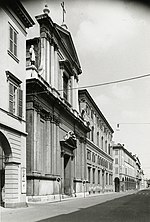Maserati

Maserati S.p.A. (Italian: [mazeˈraːti]) is an Italian luxury vehicle manufacturer. Established on 1 December 1914 in Bologna, Italy, the company's headquarters are now in Modena, and its emblem is a trident. The company has been owned by Stellantis since 2021. Maserati was initially associated with Ferrari. In May 2014, due to ambitious plans and product launches, Maserati sold a record of over 3,000 cars in one month. This caused them to increase production of the Quattroporte and Ghibli models. In addition to the Ghibli and Quattroporte, Maserati offers the Maserati GranTurismo and two SUV models, the Maserati Levante (the first ever Maserati SUV) and the Maserati Grecale. Maserati has placed a yearly production output cap at 75,000 vehicles globally.
Excerpt from the Wikipedia article Maserati (License: CC BY-SA 3.0, Authors, Images).Maserati
Via Divisione Acqui, Modena Musicisti
Geographical coordinates (GPS) Address Nearby Places Show on map
Geographical coordinates (GPS)
| Latitude | Longitude |
|---|---|
| N 44.6493 ° | E 10.9408 ° |
Address
Via Divisione Acqui
41100 Modena, Musicisti
Emilia-Romagna, Italy
Open on Google Maps








